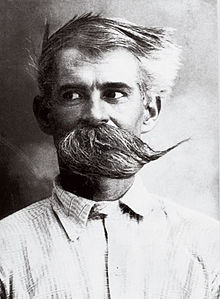George Ohr
| George E. Ohr | |
|---|---|

The "Mad Potter of Biloxi"
|
|
| Born | July 12, 1857 Biloxi, Mississippi |
| Died | April 7, 1918 (aged 60) |
| Nationality | American |
| Known for | Pottery |
| Spouse(s) | Josephine Gehring |
George Edgar Ohr (July 12, 1857 – April 7, 1918) was an American ceramic artist and the self-proclaimed "Mad Potter of Biloxi" in Mississippi. In recognition of his innovative experimentation with modern clay forms from 1880–1910, some consider him a precursor to the American Abstract-Expressionism movement.
George Ohr was born in Biloxi, Mississippi, on July 12, 1857. He was the son of German immigrants who arrived in New Orleans c. 1850 and subsequently married and moved to Biloxi. George Ohr tried his hand at various trades before he became interested in ceramics in 1879, while an apprentice of Joseph Fortune Meyer. Ohr married Josephine Gehring of New Orleans on September 15, 1886. Ten children were born to the Ohrs, but unfortunately only 5 survived to adulthood. George Ohr died of throat cancer on April 7, 1918.
Ohr studied the potter's trade with Joseph Meyer in New Orleans, a potter whose family hailed from Alsace-Lorraine, as did Ohr's. Ohr's father had established the first blacksmith shop in Biloxi and his mother ran an early, popular grocery store there. In his lifetime, Ohr created well over 10,000 known pots. He called his work "unequaled, undisputed, unrivaled." In 1884, Ohr exhibited and sold his pottery at the World's Industrial and Cotton Centennial Exposition in New Orleans. Of the hundreds of pieces he showed, Ohr boasted "no two alike."
The 1894 fire that burned most of Biloxi also destroyed Ohr's workshop, and it has been noted that Ohr's post-fire works show tremendous "energy" and "fluidity." George Ohr called his pots "mud babies". Upon the destruction of his workshop and his work, he gathered the pieces that survived the fire, and although burned, he kept each piece, calling them his " burned babies".
Ohr's work is now seen as ground-breaking and a harbinger of the abstract sculpture and pottery that developed in the mid-20th century; his pieces are now relatively rare and highly coveted.
A notable feature of Ohr's pottery is its thin walls, metallic glazes, and twisted, pinched shapes; to this day, few potters have been able to replicate them using a pottery wheel, which is how Ohr made his works. Ohr dug much of his clay locally in southern Mississippi from the Tchoutacabouffa River. Tchoutacabouffa is the Biloxi tribe's word for "broken pot."
...
Wikipedia
